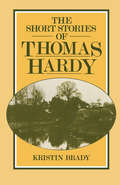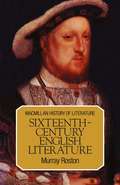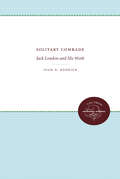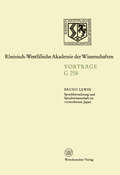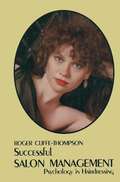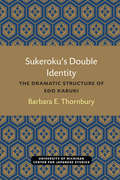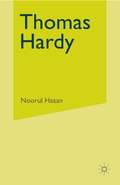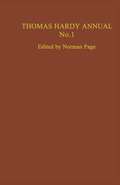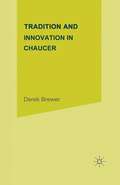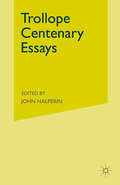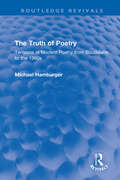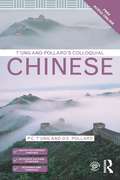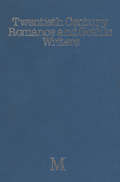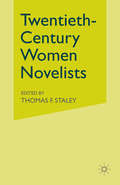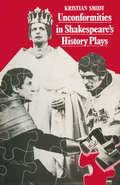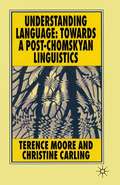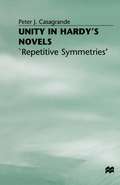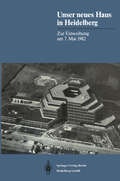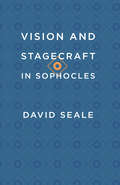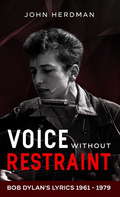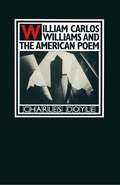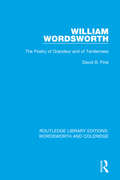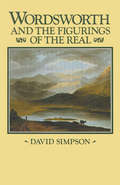- Table View
- List View
Sixteenth-Century English Literature (Macmillan History of Literature)
by Murray RostonThe sixteenth century marked a remarkable revival in literary output in England. In this wide ranging and dynamic study Murray Roston argues that the century's writers possessed a unique dual vision of man, which sets their work apart from their predecessors. The development of the English language, the use of new poetic forms, the growth of the playhouse, and the arrival of the middle-class rather than the nobleman writer on the literary scene, are just some of the themes discussed.
Solitary Comrade: Jack London and His Work
by Joan D. HedrickHedrick examines London's inner life, primarily as it is revealed in his art, to discover the man concealed beneath the public persona. Although London was wealthy, famous, and one of the last great self-made men in America, Hedrick shows that he was always torn by his troubled relationship to his lower-class origins. He lived in painful awareness of the contradictions between the man's world of the lower classes--at the workplace, on the road, and in prison--and the woman's world of the middle class in which he took refuge.Originally published 1982. A UNC Press Enduring Edition -- UNC Press Enduring Editions use the latest in digital technology to make available again books from our distinguished backlist that were previously out of print. These editions are published unaltered from the original, and are presented in affordable paperback formats, bringing readers both historical and cultural value.
Sprachbetrachtung und Sprachwissenschaft im vormodernen Japan: 260. Sitzung am 14. Oktober 1981 in Düsseldorf (Rheinisch-Westfälische Akademie der Wissenschaften #G 258)
by Bruno LewinSukeroku’s Double Identity: The Dramatic Structure of Edo Kabuki (Michigan Papers in Japanese Studies #6)
by Barbara E. ThornburyThe aim of this book is to show that seemingly illogical double identity of the townsman, Sukeroku, and the samurai, Soga Goro, in the play Sukeroku is a surviving element of what was once a complex and coherent structure based on a traditional performance calendar. To show how the calendar function and what Sukeroku's double identity signifies, the book is divided into two parts. Part One studies the structure of Edo kabuki. The first chapter, which outlines that structure, is based for the most part on writings of the Tokugawa period. The second chapter then looks at the concepts of sekai, "tradition," and shuko, "innovation." Kabuki was the product of material that had become a familiar part of Japanese culture by repeated use and dramatization over long periods of time, starting before kabuki began, and material that was relatively new and was used to transform the older, set material. The double identity in Sukeroku came about as a result of this interplay between what was received by way of traditional and what was added by way of innovation. Part Two considers the significance of the double identity. The author concludes that Sukeroku's double identity gave Edo audiences a hero who was an idealization of the contemporary Tokugawa townsman and at the same time a transformation of a samurai god-hero of the past. The first chapter of Part Two traces the development of Sukeroku's Soga Goro/samurai identity, from its origins in the early dramatic forms of no, kowaka, and ko-joruri, to the representation of Soga Goro in kabuki by Ichikawa Danjuro I. The seconds then looks at the transformation of Soga Gorointo Sukeroku by discussing the origins of Sukeroku and its introductions to Edo kabuki by Ichikawa Danjuro I and his son, Danjuro II, since their work was the basis of all later developments.
The Truth of Poetry: Tensions in Modern Poetry from Baudelaire to the 1960s (Routledge Revivals)
by Michael HamburgerFirst published in 1982, The Truth of Poetry attempts to answer a seemingly simple question: What kind of truth does poetry offer in modern times? Michael Hamburger’s answer to this question ranges over the last century of European and American poetry, and the result is a phenomenology of modern poetry rather than a history of appreciations of individual poets. Stressing the tensions and conflicts in and behind the work of every major poet of the period, he considers the many different possibilities open to poets since Baudelaire. This expansive work of analysis will be of interest to students of English literature, poetry enthusiasts and literary historians.
The Truth of Poetry: Tensions in Modern Poetry from Baudelaire to the 1960s (Routledge Revivals)
by Michael HamburgerFirst published in 1982, The Truth of Poetry attempts to answer a seemingly simple question: What kind of truth does poetry offer in modern times? Michael Hamburger’s answer to this question ranges over the last century of European and American poetry, and the result is a phenomenology of modern poetry rather than a history of appreciations of individual poets. Stressing the tensions and conflicts in and behind the work of every major poet of the period, he considers the many different possibilities open to poets since Baudelaire. This expansive work of analysis will be of interest to students of English literature, poetry enthusiasts and literary historians.
T'ung & Pollard's Colloquial Chinese
by P.C. T'ung D.E. PollardT’ung and Pollard’s Colloquial Chinese course is the ideal introductory course for all dedicated learners of Mandarin Chinese. Written by experienced teachers, the course provides a rigorous introduction to the pronunciation, vocabulary and grammar of Mandarin Chinese. By the end of this rewarding course learners will be able to communicate confidently in a wide variety of situations. The solid foundation provided is also ideal for those who wish to advance their language skills to higher levels. Divided into 17 lessons, each lesson contains conversations based on common daily situations, vocabularies, grammar notes and exercises to help learn and practice basic skills. Key features include: clear grammar explanations lots of exercises for regular practice Pinyin Romanization used throughout Chinese-English glossary for quick reference. Audio material to accompany the course is available to download free in MP3 format from www.routledge.com/cw/colloquials. Recorded by native speakers, the audio material features the dialogues and texts from the book and will help develop your listening and pronunciation skills.
Vision and Stagecraft in Sophocles
by David SealeIn this study, David Seale argues that Sophocles’s use of stagecraft, which has thus far received little attention, was as sophisticated as that of Aeschylus or Euripides. His discussions of the physical and visual elements of Sophocles's seven plays center around the theme of sight; he demonstrates that each play is staged to maximize the implications and effects of “seeing” and not “seeing,” of knowledge and ignorance. This emphasis on visual perception, Seale maintains, harmonizes with Sophocles’s use of verbal and thematic techniques to create dramatic movements from delusion to truth, culminating in climaxes that are revelations—moments when things are truly “seen” by both audience and characters.
Voice Without Restraint: Bob Dylan's Lyrics 1961 - 1979
by John HerdmanBob Dylan was awarded the Nobel Prize in Literature in June 2016, and seldom in recent years has it been more richly deserved.That a song writer’s lyrics should be regarded as literature was an idea at which many were surprised.Others have felt that to isolate the lyrics of a song from its musical context is unreal. Ultimately that is true: a song is an indefeasible whole, an inseparable marriage of words and music which achieves its overall emotional effect by that symbiosis and not otherwise.Yet it can also be said that the two components can be separately considered as two elements in the artist’s creative utterance, and discussed as such.The evidence of Dylan’s manuscripts supports the view that in writing his lyrics his way of going about things is not always widely different from that of a poet.Bob Dylan commented on the Nobel Prize in Literature which was awarded to him "for having created new poetic expressions within the great American song tradition": "When I first received this Nobel Prize for Literature, I got to wondering exactly how my songs related to literature. I wanted to reflect on it and see where the connection was."Voice Without Restraint, refers to and is from the song “I dreamed I saw St Augustine” on John Wesley Harding, and is a phrase chosen to evoke the full-blooded commitment to his artistic utterance which is the hallmark of Bob Dylan’s voice – in all senses.
William Wordsworth: The Poetry of Grandeur and of Tenderness (RLE: Wordsworth and Coleridge)
by David B. PirieFirst published in 1982. In this study of Wordsworth’s major poetry, the author explores the conflict between the poet’s celebration of an impersonal earth and his concern for the most intensely personal relationships. The opening chapter concentrates on Wordsworth’s struggle to describe the natural world and the extraordinary claims he makes for the natural landscape — which are shown to derive not from vague mysticism but precisely articulated common sense. The close readings of Michael, The Idiot Boy, Tintern Abbey and The Ruined Cottage, and poems as passages on solitaries are supported by generous quotations and discussion of other critical views.
William Wordsworth: The Poetry of Grandeur and of Tenderness (RLE: Wordsworth and Coleridge)
by David B. PirieFirst published in 1982. In this study of Wordsworth’s major poetry, the author explores the conflict between the poet’s celebration of an impersonal earth and his concern for the most intensely personal relationships. The opening chapter concentrates on Wordsworth’s struggle to describe the natural world and the extraordinary claims he makes for the natural landscape — which are shown to derive not from vague mysticism but precisely articulated common sense. The close readings of Michael, The Idiot Boy, Tintern Abbey and The Ruined Cottage, and poems as passages on solitaries are supported by generous quotations and discussion of other critical views.
Wordsworth and the Figurings of the Real
by David SimpsonPerhaps the most powerful feature of the Romantic imagination is its ability to dissolve existing form and order and create it anew. The Romantic investigation of the functions of the imagination also leads to important insights concerning its problems and dangers. Because it separates the person experiencing it from others around him, the imagination introduces ways of seeing which cannot be assumed to be simply communicable or easily shared, and which have as their objects different forms or 'things'. These forms, or figures, risk becoming for their originators both vehicles of power, in so far as they do convince others of their reality, and limiting constructs of prefigured order, inhibiting their users from the perception of new relations and alternative meanings. When the figured becomes the real, there thus arise difficulties in both individual and social perceptions. Arguing from the stance that all perception takes place by a creative (and hence potentially divisive) assembly of images or qualities into things, David Simpson shows that the analysis of figurative representation in Wordsworth's writing is of central importance to his idea of the human mind, and the way in which it is affected or allowed to function by its environment, both human and physical. In this way Wordsworth's ideas about the function of literature in society are seen to be more fully worked out than readers have often assumed them to be. Simpson pays particular attention to the ethical consequences of different ways of figuring the real, offering an explanation of Wordsworth's distinction between life in the town and life among the mountains and lakes of north-west England. In relating Wordsworth's poetry to important contemporary debates in political economy such as those concerning the division of labour and the evaluation of the advantages and disadvantages of commerce and luxury, he suggests that Wordsworth is a notable precursor of that nineteenth-century tradition which sees the mind as open to critical determination by social and environmental factors.
